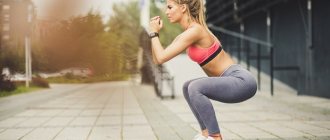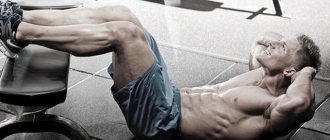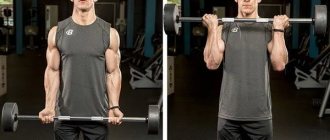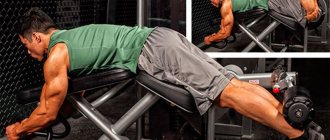Share:
A platform leg press machine can be found in almost every sports club, since the leg press is an excellent exercise aimed at working the leg muscles. It can be used both during the period of gaining muscle mass and during cutting to give relief and definition to the muscles. In addition, it can significantly increase the intensity of a workout and for this reason is successfully used both in fitness and bodybuilding, as well as in functional training.
Depending on the placement of the feet on the platform and the range of motion, when doing the leg press in the machine, you can work out different muscle groups:
- quadriceps;
- inner and back thighs;
- gluteal muscles.
Of course, the bench leg press cannot completely replace heavy squats with a barbell, but it still creates very serious stress on your muscles. Subject to high-quality recovery, proper rest, periodization of exercise and proper nutrition, this will lead to muscle hypertrophy and an increase in strength indicators in basic exercises.
After reading this article, you will learn how to do a leg press, how you can replace this exercise, and how to use it to achieve a truly serious increase in muscle volume.
What muscles work?
With this exercise you can locally load any muscle group in the lower body. It should be understood that the narrower we place our legs, the more the quadriceps is involved in the work.
Vertical press
In addition to the classic angled leg press, there is also a vertical leg press. With a vertical leg press, the platform is strictly perpendicular to the athlete’s position. The movement is carried out in a fairly short amplitude. This allows you to isolate the load on the lower part of the quadriceps (teardrop muscle), which will make the leg bulkier in the lower thigh, closer to the knee. In Russia, this exercise machine has not yet become particularly widespread, and it can only be found in premium class fitness clubs. However, nothing prevents you from doing almost the same thing in a regular Smith machine; for normal execution you only need the help of an experienced partner who will open and close the safety mechanisms.
Horizontal press
There is also a horizontal leg press. Working in this simulator, you increase the range of motion by several centimeters. This is what makes this machine so special: you do a huge amount of work without using a huge amount of weight. Also, this version of the exercise perfectly works the lateral head of the quadriceps, making the thigh visually larger and more muscular.
In all these variations, the abdominal muscles and spinal extensors serve as stabilizers. Without a strong lower back and core muscles, it is unlikely that you will be able to perform a technically correct leg press with a decent weight. The leg press machine is also great for working the calf muscles. The exercise technique is exactly the same as in a block exercise machine for standing calves, where the athlete rests his trapezius on the roller. There are no particular differences between these two exercises; choose the option that is more convenient for you to do.
Recommendations for implementation
There are several simple techniques that will help you load the quadruple major thigh muscles in a new way. It's about:
Full and partial amplitude. If we fully extend the leg, then the load falls more on the broad medial head. But if we work with a little more weight in a partial amplitude. That is, extend your leg halfway. Then the direct and intermediate heads will be involved in the work. When using partial amplitude, you will need to tilt the back slightly back. This will stretch these heads more.
Turning the feet. The position of our legs also determines which head will receive the most load. If you turn your feet inward towards each other. This will stretch the lateral head more, and it will be used more than the others. Turning your toes to the sides will shift the emphasis to the medial head.
One leg extension. This is a more professional technique, beginners do not need it
Performing an extension with one leg, it is easier to focus on the work of the hip. Also, using this exercise, you can reduce the imbalance in the development of the quadriceps of each leg.
You can try each of these techniques. The main criterion should be the correct execution technique. So work on it before making these kinds of changes to the exercise.
The benefits and harms of exercise
The leg press in the machine is the second exercise after classic squats with a barbell for building strong and massive legs. With its help, you can perfectly develop the muscles of the legs without creating excessive axial load on the cervical and thoracic spine.
Benefit
Most athletes find it much easier to focus on their footwork when performing a leg press than when performing a back or shoulder squat. We all remember very well that a developed neuromuscular connection is simply necessary for muscle growth and progress in strength indicators. So, to tone your muscles and gain muscle mass, the leg press is perfect. Of course, heavy basic squats are no less important for this, and this should not be forgotten. Especially if you are a beginner and your priority is to build some strength foundation in basic movements with free weights. Without this, moving on will be much more difficult. By squatting, we increase hormonal levels and set the preconditions for progress. By doing this exercise, we begin to “polish” what we established with squats.
To give the leg muscles relief and rigidity, experienced athletes can be advised to perform the leg press in a super series with other exercises. For example, squats, lunges with a barbell and leg extensions while sitting in a machine. Such a complex load on the quadriceps will lead to a strong pump, which will allow you to have sculpted and toned legs even when the level of body fat exceeds 12-15%.
Injury hazard
Potentially, the machine leg press is one of the most injury-prone exercises you can do in the gym. Perhaps it can be put on a par with deadlifts and squats with a barbell. However, this issue is directly related to the technique of performing the exercise and the athlete’s excessive egocentrism.
Many athletes perform the exercise as follows: hang a huge weight (from 500 kg and above) and perform 3-5 repetitions with an amplitude of no more than 15 centimeters. Remember, you've probably seen this more than once. This should not be done under any circumstances. Sooner or later, this approach to strength training will lead to serious injury, and you risk quitting the sport forever.
In the leg press, the most important thing for us is the feeling of the muscles working. Working in such a low rep range, this is impossible to achieve - failure will occur faster than you achieve blood flow to the muscles. In addition, in the leg press the amplitude of movement is important to us, and these 10-15 centimeters are clearly not enough. You need to lower your legs as low as you can stretch, without lifting your tailbone from the machine.
Crazy working weight is not needed here either. Work with a weight that you can do 10 reps or more with. If you are already an experienced athlete and are able to technically perform clean leg presses with heavy weights, use knee wraps to minimize the risk of injuring your knee ligaments.
Contraindications for implementation
There are a number of situations in which you should refuse to use the exercise during training:
- This exercise is not recommended for athletes who have suffered injuries to the knee joints and ligaments. Working in this trajectory, and even with a lot of weight, can lead to recurrence of the injury and serious complications.
- In addition, the leg press puts stress on the lumbar spine. Not as strong as squats and deadlifts, but enough to make your problems worse. Therefore, under no circumstances should such a load be applied to athletes with hernias or protrusions in the lumbar spine.
- With scoliosis, lordosis or kyphosis, you can perform this exercise, but very moderately, with light weights and under the constant supervision of a fitness instructor. It is recommended to use an athletic belt - this will slightly relieve the load on the lower back. However, do not tighten it too tightly - during leg presses we need even and unimpeded breathing.
The arsenal of leg exercises is quite large, so there is always something to replace the leg press. If for a number of medical reasons this particular exercise is contraindicated for you, replace it with various variations of lunges with a barbell and dumbbells, a hack squat or a Jefferson deadlift. The axial load on the lumbar spine in these exercises is much lower, and you can concentrate on high-quality pumping of the leg muscles.
Description
Extending your arms at the elbow joints, lift the handles of the simulator up. Return to the starting position, pausing briefly before the bottom point and feeling the tension in your muscles. Repeat the exercise.
Recommendations for implementation
- Learn to perform the exercise confidently before increasing the weight.
- Do not use inertial force or springy hand movements.
- Exhale as you lift the handles of the machine.
- Don't squeeze your shoulder blades. They should be spread out and down
Main stabilizing muscles
We recommend reading: Back workout for girls in the gym
- Shoulder blade: serratus anterior, pectoralis minor, lower trapezius.
- Shoulder joint: rotator cuff, biceps.
- Torso: abdominal muscles, gluteal muscles, rhomboid muscles, trapezius muscle, latissimus dorsi muscle.
Initial position
- Adjust the handles so that in their lowest position they are slightly below chest level.
- Lie on your back and place your legs bent at the knees on a bench or floor for stability.
- Straighten your spine.
- Grasp the handles and lift them so that they are slightly above chest level.
Motion Analysis
Major joints
Movements performed in the joints
Up: extension. Down: flexion.
Upward: horizontal adduction, flexion. Down: horizontal abduction, extension.
Up: partial inward rotation, extension.
Down: partial outward rotation, flattening.
Main muscles involved in movements
Triceps, elbow muscle
Pectoralis major muscle (mainly sternocostal and clavicular bundles), coracobrachialis muscle, anterior deltoid bundle
We recommend reading: Cocktails for weight loss at home in a blender - recipes
Leg press options
There are three types of simulators for performing this exercise:
- at an angle;
- vertical;
- horizontal.
Angle press
The angled leg press machine is one of the most common machines in all fitness clubs in the world. During execution, the angle between the athlete’s torso and the platform is approximately 45 degrees. This allows you to work in a fairly large amplitude and use serious weight. The other two types of leg press machines have not yet received the widespread distribution they deserve in Russian gyms. It’s a pity, because with their help you can perfectly diversify the load and force the leg muscles to work at new angles, which will lead to even greater progress.
Vertical Leg Press
The beauty of the vertical leg press is that the vector of movement fundamentally changes. The knees do not fall towards the shoulders, but towards the stomach. Because of this, it is easier for us to focus on the work of the quadriceps, especially if we use a narrow parallel stance. It is not recommended to perform leg press variations for the buttocks or hamstrings on a vertical press machine. The slightest technical mistake will result in the tailbone being twisted and lifted upward. This position of the lower back during strength exercises is extremely dangerous.
Horizontal trainer
The horizontal leg press machine is an even rarer beast. But damn interesting and effective. The seat and the bench press platform are in the same plane, there is almost no inclination. This significantly increases the range of motion. Some exercise machines help you add an extra 10-15 centimeters! At first it may turn out that there is no significant difference, but these additional centimeters significantly complicate the task, as new “dead spots” appear. And the working weight immediately becomes less by almost a quarter. The muscles simply begin to tear apart from the strongest pumping.
Load Variations
The load when performing a leg press can be varied in different ways of positioning the legs.
- We place our feet parallel and narrowly - the leg press turns into an isolated exercise for the quadriceps, the adductor muscles of the thigh and buttocks cease to participate in the movement.
- If we place our feet at the very bottom of the platform, we will increase the range of motion, and the quadriceps will do even more work.
- By turning your feet outward at 45 degrees and keeping your feet wide, the leg press will target your inner thighs, hamstrings, and glutes.
- When doing a leg press for the buttocks, the legs should be placed at the very top of the platform. Blood filling and burning sensation are guaranteed.
Use different options and do not forget about the principles of load periodization. Then you will get proportionally developed and aesthetic leg muscles.
Exercise technique
Regardless of which variant of the exercise you perform, the basic principles and technique of performing the exercise are always the same, so we will tell you the rules common to all variants on how to do a leg press:
- We are located in the leg press machine. The back should be completely pressed, especially in the lumbar region.
- We place our feet at the desired angle. . We raise the platform until the knees are fully extended and open the safety mechanism. We firmly hold the handles on the sides of the machine with our hands.
- Inhaling, we smoothly lower the platform down. All the weight lies on the heels, we try not to transfer the center of gravity to the front of the foot, otherwise you will immediately lose control of the movement. The negative phase of the movement is very important both for working the muscles and for avoiding injury. It is very important to monitor the position of the knee when lowering the platform down: under no circumstances should it turn inward.
- We lower the platform as deep as possible. Of course, within reasonable limits, there should be no pain or discomfort. The lower back should also not come off the machine at the lowest point.
- Without pausing at the bottom point, we begin to squeeze the platform up. At the same time, we exhale sharply. It is not necessary to raise the platform completely; it is better not to complete the movement by about five centimeters. This way the muscles will have no time to rest, and the effectiveness of the approach will increase. In addition, fully straightening your knees at the top, and even when working with heavy weight, can be very dangerous. There are times when the legs simply cannot stand it and bend in the opposite direction. Extremely rare, but they do happen. The platform then falls directly on the athlete.
Debriefing: the most common mistakes in the bench press
The bench press is much more difficult than it may appear to those unfamiliar with it. Perhaps the most common mistake is to bounce the barbell off the chest. The bar needs to be lifted quickly, but not thrown up - this will only create additional pressure on the chest. And it becomes difficult to say for sure how much weight is actually squeezed. Many athletes do not pay attention to breathing, not realizing what a huge role it plays in the correct execution of the bench press. But try to breathe correctly at least once - and you will be pleasantly shocked at how much weight you can take!
The positioning of the elbows at the bottom point of the press is of great importance - if you take it lightly, you can get injured. It is also important not to raise your shoulders at the top of the press. Due to inexperience, it may seem that in this way you can help yourself, but in fact, this can only cause you to lose stability.
To the bench!
Theoretical knowledge in the field of safe and effective bench press has been obtained - it’s time to put it into practice! Like other exercises, the bench press loves practice: the more extensive it is, the better the exercise itself will turn out. As soon as all the movements are realized and felt, the weights will begin to grow steadily! It's worth a try!









